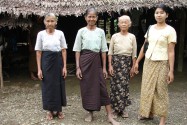English version below
Traditionnellement, femmes et hommes birmans portent le longy : pahso pour les hommes et htamein pour les femmes, tissu cousu en tube, noué autour de la taille. Son choix et son usage suivent des règles précises : ils sont à carreaux pour les hommes, à fleurs ou à rayures pour les femmes, et vert uni pour les professeurs du primaire et leurs élèves. Les longys féminins ont toujours une bande de tissu noir, solide et bon marché, qui permet de faire le nœud en tirant fort sans abimer le tissu. Les femmes le renouent de nombreuses fois dans la journée en un geste gracieux : elles le tirent sur le côté droit, forment un pli pour le rabattre devant, et rentrent l’extrémité de tissu noir à l’intérieur de la ceinture.
Pour les hommes, les choses semblent plus compliquées ! Ils forment un pli creux, sur le devant, tirebouchonnent le tissu en un savant nœud boule. A l’heure de jouer au chinlon ou si leur travail l’exige, ils adoptent la «version courte », ramenant le tissu de l’arrière entre leurs jambes et le passant dans la ceinture.
Traditionally, Burmese people wear a longy: pahso for men and htamein for women, tube-stitched fabric, knotted at the waist.
Its choice and use follow precise rules: they are checkered for men, flower or striped for women, and plain green for primary school teachers and their students. Women’s longys always have a strong and cheap black fabric band, which allows them to tie a knot by pulling hard without damaging the fabric. Women often ajust it in a graceful gesture: they pull it on the right side, fold it in front, and tuck the end of the black fabric band inside the belt.For men, things seem more complicated! They form a hollow fold, on the front, pull the fabric into a clever ball knot. When playing chinlon or if their work requires it, they adopt the «short version», bringing back the fabric from the back between their legs and passing it in the belt.
